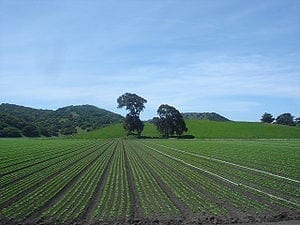
An overzealous effort at protecting consumer from foodborne illness in California may be having unforeseen consequences on biodiversity, sustainability
Clean greens are healthy greens.
Or so thought a coalition of farmers, growers and processers in California when, in response to a deadly spinach outbreak of the bacteria Escherichia coli (E. coli), they created a new set of bacteria-minimizing standards for growing and handling leafy greens.
Although the standards were designed to eliminate potential sources of contamination by mandating that crop sites be cleared of vegetation and kept a certain distance from wildlife and natural bodies of water, they have had some unintended consequences—namely, the destruction of habitats, the degradation of soil and the pollution of rivers and streams.
Researchers found that the 2006 regulations, corporate standards enforced through third-party audits, have not only been ineffective at reducing the risk of food-borne illness, but have contributed to a loss of ecological diversity in the Salinas River Valley, an area of California prized for its variety of animal and plant life and the center of production for 70 percent of America’s leafy greens.**
A study, published in the May 6 edition of Frontiers in Ecology and the Environment, measured changes farmers and growers made to the environment between 2005 and 2009. Using satellite images from the National Agriculture Imagery Program, researchers broke the 15,000-hectare study area into ecological communities defined by vegetative type. The greatest amount of habitat loss, they found, occurred in transitional communities, where fast-growing grasses, shrubs and trees depend on constant disturbance for survival.
Researchers discovered that the new farming practices have further de-incentivized growers from farming in ways that take into account the importance of natural systems of resource cycling and plant regeneration. Instead, many have cleared land of native vegetation, erected fences and laid poison to deter the presence of wildlife. As a result of growers’ attempts to control for all potential variables on crop sites, farmed areas have become not only uninhabitable for wildlife but also more vulnerable to climate change.
Study authors say the practices are an overzealous attempt to respond to consumer concerns about foodborne illness. “There is this pressure from consumers and buyers to go above and beyond what’s necessary for clean food,” says ecologist Sasha Gennet, a researcher at The Nature Conservancy and the lead author of the study.
The impact of the regulations on foodborne illness has not yet been proven. Since the 2006 outbreak of E. coli was linked with spinach grown in California, at least 15 more domestic E. coli outbreaks have been reported. More than half included cases reported in California.
Iowa State University landscape ecologist Lisa Schulte Moore says the study carries important implications for the future of farming. As the epicenter for the majority of America’s leafy greens, the Salinas Valley is seen as a model of successful farming practices. If these practices continue, Moore says, other states could begin implementing farming regulations that harm the environment. “As someone who lives in one of the biggest farming states in the country, what I’m worried about is, what is this going to mean for other farmers?”
The Latest Bing News on:
Food Safety
- Senators introduce bill to limit heavy metals found in baby foodon May 10, 2024 at 4:19 am
A group of U.S. Senators are working on a new bill that would limit the amount of heavy metals that are currently found in baby food. The bill, the Bab ...
- Berks food safety inspections found evidence of insect activity and moldlike growth at another placeon May 10, 2024 at 3:53 am
Reading, Muhlenberg Township and the rest of the county. Reading and Muhlenberg Township have their own food safety inspectors and the rest of the county is inspected by Pennsylvania Department of ...
- Lehigh Valley food safety inspections: Utensils on the floor, flies on the wall, rodents in the storeroomon May 10, 2024 at 2:00 am
Here are the food safety inspection reports from Lehigh and Northampton counties, conducted the week of April 28. Each week, we highlight the inspection reports provided through the Pennsylvania ...
- Here’s where DineSafe inspectors found major food safety violations this weekon May 10, 2024 at 1:52 am
In total 14 conditional passes were issued restaurants, bars, cafés, bakeries and grocery stores between May 2 and May 8 ...
- Klobuchar introduces new baby food safety bill in wake of lead-tainted applesauce complaintson May 9, 2024 at 2:37 pm
The bill would allow the FDA to enforce limits on heavy metals in commercial infant and toddler food and increase standards for sampling and testing of foods processed domestically.
- Lawmakers target heavy metals in baby food with new legislationon May 9, 2024 at 9:52 am
A pair of Democratic senators introduced new legislation to limit the levels of harmful metals in commercial baby food, they announced Thursday. The bill, called “The Baby Food Safety Act of ...
- Determining Food Safety Challenges Amid Rising Grocery Priceson May 9, 2024 at 6:24 am
Grocery prices are going up, and it’s not just affecting your wallet. There’s a concern for your health too. Food prices have gone up by 21% in the last three years, which is more than the prevailing ...
- New bill aims to limit harmful heavy metals found in baby foodon May 9, 2024 at 4:00 am
US lawmakers plan to introduce a bill Thursday that aims to limit the amount of heavy metals found in baby food through stronger regulation and enforcement by the US Food and Drug Administration.
- Food safety line item sought to help the FDA with the human food programon May 8, 2024 at 9:00 pm
A food safety line item in the federal budget would go a long way toward “bringing clarity and certainty” to the human foods programs of the Food and Drug ...
- Food Safety Summit Keynote Focuses on Food Safety Leadershipon May 8, 2024 at 4:32 pm
Mary Weaver Gertz, chief food safety and quality assurance officer at Yum! Brands shared advice on finding your way as a food safety leader in her May 8 Food Safety Summit keynote speech, “Being Right ...
The Latest Google Headlines on:
Food Safety
[google_news title=”” keyword=”Food Safety” num_posts=”10″ blurb_length=”0″ show_thumb=”left”]
The Latest Bing News on:
Fix the internet
- T-Mobile delays free internet loophole fix after running into a problemon May 9, 2024 at 1:40 pm
T-Mobile has reportedly delayed the roll out of address verification on gateways, as well as the launch of the new Away plan.
- State accepting challenges fix broadband mapping errorson May 7, 2024 at 8:02 pm
New Mexico has been allocated nearly $700 million to connect unconnected or poorly connected areas in the state to broadband, but to make sure the right households are reaping the benefits of that ...
- 5 Ways to Fix the GTA V “Rockstar Game Services are Unavailable” Error on Windows PCson May 7, 2024 at 5:53 am
Here, we look at how you can fix Grand Theft Auto V’s “Rockstar game services are unavailable” error on Windows 11/10 PCs. Are you another player who can’t play GTA V or GTA Online because of that ...
- 9 Fixes for the "No Internet Secured" Error on Windows 10on May 6, 2024 at 3:35 am
Running into the "No Internet, secured" message? Fix this common wireless error with these tips and get back online.
- Slow Wi-Fi in Your Apartment? Here's How to Fix Iton May 3, 2024 at 6:00 am
A laggy internet connection makes streaming, gaming and web surfing frustrating. Here are CNET’s tips for getting a stronger signal throughout your place. Trey Paul is a CNET senior editor ...
- Give small businesses the ‘right to repair’on May 2, 2024 at 7:00 am
Thankfully, bipartisan members of Congress have introduced a commonsense proposal that would benefit small businesses and consumers: the Right to Equitable and Professional Auto Industry Repair Act.
- 5 Ways to Fix the Failed-to-Connect-to-Server Minecraft Error on Windows PCson April 30, 2024 at 9:25 am
This troubleshooting guide provides some possible resolutions for fixing the Minecraft error message that says, “Failed to connect to the server.” Are you seeking a fix for that server connectivity ...
- Is your internet being throttled? How to test and fix your speedson April 30, 2024 at 7:24 am
Learn more about why internet providers throttle your internet speed, how to tell when it's happening and what to do to prevent it.
- How to Fix the "No Internet Secured" Error on Windowson April 26, 2024 at 8:00 am
The message "No Internet, Secured" usually appears when your connection is weak. You can reboot your router to refresh your network, which might also improve its speed. Alternatively, you can also ...
- PS5 won’t connect to the internet? Here’s how to fix iton April 25, 2024 at 5:00 pm
However, many have faced difficulties with connecting their PS5 consoles to the internet. Before you rush to the nearest Sony store, use the troubleshooting tricks below to fix internet issues on PS5.
The Latest Google Headlines on:
Fix the internet
[google_news title=”” keyword=”fix the internet” num_posts=”10″ blurb_length=”0″ show_thumb=”left”]











